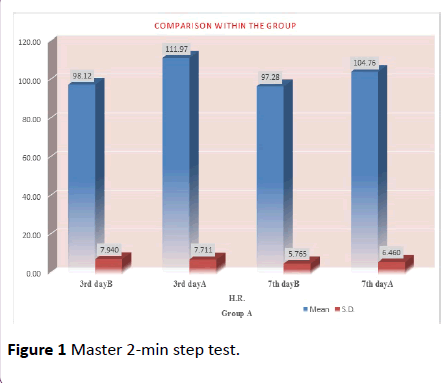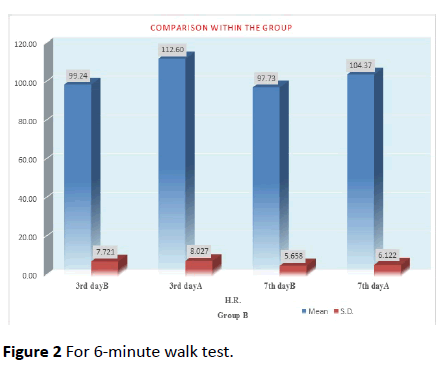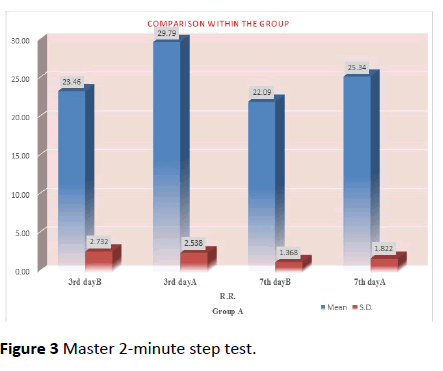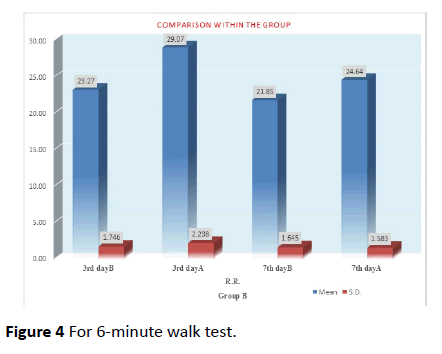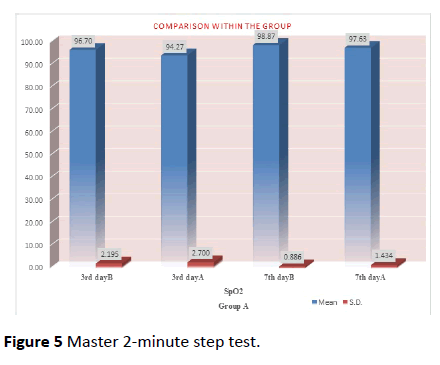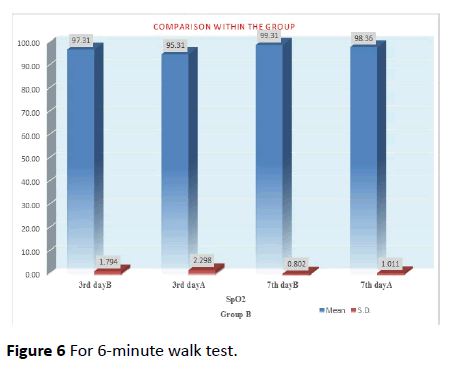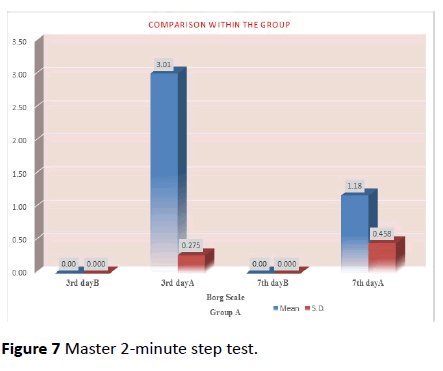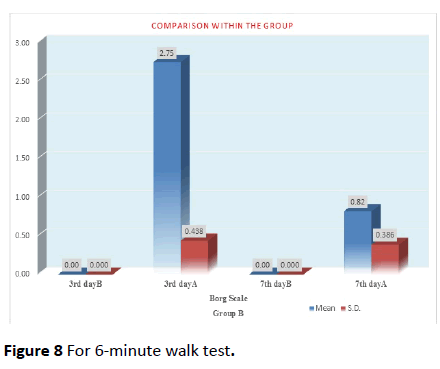ISSN : 2574-2825
Journal of Nursing and Health Studies
To Study the Effect of Post-Operative Physiotherapy Management in PostCABG Patients
Gaurav Kapoor*, Som Gupta and Ammar Faisal Khan
Mahaveer Physiotherapy and Slimming Clinic, Ludhiana, Punjab, India
- *Corresponding Author:
- Gaurav Kapoor
Mahaveer Physiotherapy and Slimming Clinic, Ludhiana, Punjab, India
Tel: 9872400711
E-mail: gaurav_kapoor2000@yahoo.com
Received date: August 03, 2017; Accepted date: August 16, 2017; Published date: August 16, 2017
Citation: Kapoor G, Gupta S, Khan AF (2017) To Study the Effect of Post-Operative Physiotherapy Management in Post CABG Patients. J Nurs Health Stud Vol.2:No.2:13. doi: 10.21767/2574-2825.100019
Abstract
Backround: Coronary Artery Bypass Graft (CABG) surgery is a form of heart surgery that redirects blood around clogged arteries to increase blood flow and oxygen to the heart.
During CABG surgery, the surgeon uses a portion of a healthy vessel (either an artery or vein) from the leg, chest, or arm to create a bypass around the clogged artery. Patients typically receive 1 to 5 bypasses per operation depending on how many coronary arteries (and their main branches) are blocked.
During CABG surgery with cardiopulmonary bypass a heart-lung machine artificially maintains blood circulation and oxygenation while the surgeon operates on the heart.
Aims and Objectives: To increase cardiac efficiency, increase exercise tolerance or endurance and to get the effective and better post-operative results. Further at the end of the study we should be able to plan out an effective treatment plan for post-operative CABG patients and know the effect of Master 2-minute step test and 6- minute walk test in post–operative CABG patients.
Methodology: Study was conducted in Hero DMC heart institute in Punjab. Sixty-seven study participants (aged between 40 years to 70 years) were randomly recruited to the study. Recruited study participants received treatment in two sessions that is master 2-minute step test procedure was used in morning and 6-minute walk test procedure was used in evening session. Assessment and reassessment was done before and after completion of treatment procedure on every day and data was collected using assessment format for 3rd and 7th day.
Outcome measures: Primary outcome in both master 2- min step test and 6-min walk test showed that there occurs decrease in heart rate, respiratory rate, increase in oxygen saturation and decrease in exertion. Secondary outcomes included more decrease in heart rate, respiratory rate and fatigue and increase in oxygen saturation. Improvement in faster heart function elaborated from the Heart rate (p<0.05) with both procedures that is master 2-minute step test and 6- minute walk test.
Conclusion: The result obtained after statistical analysis shows that both master 2-minute step test and 6-minute walk test has the additional advantage of faster recovery as analyzed from mean of the before and after exercise using Tukey’s method on both of 3rd day and 7th day.
Keywords
Cardiac rehabilitation; Cardiac physiotherapy; Physiotherapy; Cardiovascular physiotherapy
Introduction
Coronary artery bypass graft (CABG) surgery is a form of heart surgery that redirects blood around clogged arteries to increase blood flow and oxygen to the heart [1].
During CABG surgery, the surgeon uses a portion of a healthy vessel (either an artery or vein) from the leg, chest, or arm to create a bypass around the clogged artery [2]. Patients typically receive 1 to 5 bypasses per operation depending on how many coronary arteries (and their main branches) are blocked [2].
During CABG surgery with cardiopulmonary bypass a heartlung machine artificially maintains blood circulation and oxygenation while the surgeon operates on the heart [2].
Cardiac rehab is a program designed specifically for patients with cardiac patients either patient had undergone cardiac surgery or not. It includes exercise, lifestyle changes, education, and emotional support. It can help improve patient’s health and enable them to live a more active life after patient have had a heart attack or heart surgery or if patient have a long-term heart problem such as heart failure. Cardiac rehab can also help patient return to work safely and in a timely manner.
Patient may start a cardiac rehab program while he or she is still in the hospital after having treatment for a heart attack or other heart problem, soon after leaving the hospital, or at any other time to help prevent future heart problems, improve the quality of life, and make healthier. The physiotherapist will give an exercise prescription that gives patient and cardiac rehab team guidelines for the frequency, duration, and intensity of exercise. The prescription will be based on your medical condition and patients’ fitness level.
Indications
1. CABG surgery may be required in people with coronary artery disease (CAD) blood vessels can become partially or completely blocked so the heart does not receive enough oxygen, leading to angina leading to angina (chest pain) or myocardial infarction (heart attack) [3].
2. If left untreated, CAD may lead to a heart attack [3].
3. Some patients may need to undergo CABG surgery on an emergency basis during or immediately following a heart attack to limit damage to the heart [4].
4. CABG surgery is a therapeutic intervention after medication and lifestyle changes have not worked [4].
Materials and Methods
Operational tools
1. Countdown timer (or stopwatch): To measure the time duration.
2. Two small cones to mark the turnaround points.
3. A chair that can be easily moved along the walking course.
4. Worksheets on a clipboard.
5. A source of oxygen.
6. Sphygmomanometer: To measure the blood pressure.
7. Measuring tape: To measure distance covered.
8. Stepper: A 20 cm high single-step device with no handles is used [5].
9. Pulse oximeter: A device used to measure pulse and Spot [2].
Research Methodology
Type of study
This study was an experimental type of study.
Care manager
Care manager position was created and assigned to work in group practices. Trainee physiotherapist was selected for this position and given training to prepare him for the role as care manager. The initial training was followed by focused training on CABG rehabilitation. In addition, administrative and clinical issues were addressed. Supervisors were available on an as needed basis for the care manager to assist them in working with study participants. Care manager was provided with a study kit containing paper copies of the study assessments, patient education booklets and handouts, screen shots of the data fields, and feedback reports form to use in the patient treatment and assessment purpose. Further, individual supervise sessions with the project leader were available on an as needed basis for the care manager to assist him in working with study participants.
Study participants selection
Sixty-seven persons with the age group 40-70 years served as study participants. Initial screening was done using assessment format and study participants were assessed for all the inclusion and exclusion criteria.
If study participants fulfilled all the criteria of the study, they were explained about the ongoing research and all the aspects including procedures. Their informed consent form was signed and study participants were taken for study.
Inclusion criteria
1. All study participants with the age group of 40 years to 70 years.
2. Study participants with two or three vessels involvement.
3. Study participants with no endocrine abnormalities as hyper or hypothyroidism.
4. Study participants with no other organ involvement.
Exclusion criteria
1. Study participants with associated neurological and psychological abnormalities as stroke, dementia etc.
2. Study participants with cardiac pacemakers.
3. Study participants with ballooning of the vessels.
4. Study participants with post–operative complications as severe alterations in B.P., Pulse, E.C.G. abnormalities etc.
5. Study participants who showed inconsistency with initial stages of exercise rehabilitation.
6. Study participants with lower limb injury like traumatic injury.
Sample size and source
Sixty-seven study participants had been selected randomly from the Unit: Hero heart, D.M.C. and H. on the basis of clinical evaluation.
Procedure
The study participants were initially assessed using a set assessment format. The study participants were assessed for all the inclusion and exclusion criteria as defined earlier. If the study participant fulfilled all the criteria they were explained about the ongoing research and all the aspect including procedure and risks of the study. Thereafter, an informed consent form was signed and the study participants were taken for the study. Sixty-seven study participants were included in the study and were randomly assigned. After that treatment was given in two sessions that is master 2-minute step test procedure was used in morning and 6-minute walk test procedure was used in evening session. Assessment and reassessment was done before and after completion of treatment procedure on every day and data is collected using assessment format for 3rd and 7th day.
In the morning step test was performed along with basic exercises first which included chest expansion exercises, spirometery, ankle toe-movement, shoulder elevation exercises and leg stretching exercises. In the evening, same procedure was used with 6-minute walk test. Test was stopped immediately if patient complained of any type of fatigue, pain or breathlessness. Test was also stopped if any alteration in detected in patients ECG, BP or excessive fall or increase in HR. All the data collected was arranged in a tabular form and then data was analyzed using statistical calculations.
Results
Within group analysis (Figures 1-8) (Tables 1-8).
| Repeated ANOVA and Tukey's Test (Post HOC) | Group A (Master 2-minute step test) | |||
|---|---|---|---|---|
| H.R. | ||||
| 3rd dayB | 3rd dayA | 7th dayB | 7th dayA | |
| Mean | 98.12 | 111.97 | 97.28 | 104.76 |
| S.D. | 7.94 | 7.711 | 5.765 | 6.46 |
| Number | 67 | 67 | 67 | 67 |
| F test | 468.19 | |||
| Table Value at 0.05 | 2.65 | |||
| P value | <0.001 | |||
| Result | Significant | |||
| Tukey’s method (Pair wise comparison) | -- | 3rd dayB | -- | -- |
| 3rd dayA | 13.86SIG | 3rd dayA | -- | |
| 7th dayB | 0.84NSIG | 14.69SIG | 7th dayB | |
| 7th dayA | 6.65SIG | 7.21SIG | 7.48SIG | |
Table 1: Master 2-minute step test.
| Repeated ANOVA and Tukey's Test (Post HOC) | Group B (6-minute walk test) | |||
| H.R. | ||||
| 3rd dayB | 3rd dayA | 7th dayB | 7th dayA | |
| Mean | 99.24 | 112.6 | 97.73 | 104.37 |
| S.D. | 7.721 | 8.027 | 5.658 | 6.122 |
| Number | 67 | 67 | 67 | 67 |
| F test | -- | |||
| Table Value at 0.05 | 2.709 | |||
| P value | 1 | |||
| Result | Not Significant | |||
| Tukey’s method (Pair wise comparison) | -- | 3rd dayB | -- | -- |
| 3rd dayA | 13.36SIG | 3rd dayA | -- | |
| 7th dayB | 1.51SIG | 14.87SIG | 7th dayB | |
| 7th dayA | 5.14SIG | 8.23SIG | 6.65SIG | |
Table 2: For 6-minute walk test.
| Repeated ANOVA and Tukey's Test (Post HOC) | Group A (Master 2-minute step test) | |||
| R.R. | ||||
| 3rd dayB | 3rd dayA | 7th dayB | 7th dayA | |
| Mean | 23.46 | 29.79 | 22.09 | 25.34 |
| S.D. | 2.732 | 2.538 | 1.368 | 1.822 |
| Number | 67 | 67 | 67 | 67 |
| F test | 425.44 | |||
| Table Value at 0.05 | 2.65 | |||
| P value | <0.001 | |||
| Result | Significant | |||
| Tukey’s method (Pair wise comparison) | -- | 3rd dayB | -- | -- |
| 3rd dayA | 6.33SIG | 3rd dayA | -- | |
| 7th dayB | 1.38SIG | 7.71SIG | 7th dayB | |
| 7th dayA | 1.89SIG | 4.45SIG | 3.26SIG | |
Table 3: Master 2-minute step test.
| Repeated ANOVA and Tukey's Test (Post HOC) | Group B (6-minute walk test) | |||
| R.R. | ||||
| 3rd dayB | 3rd dayA | 7th dayB | 7th dayA | |
| Mean | 23.27 | 29.07 | 21.85 | 24.64 |
| S.D. | 1.746 | 2.238 | 1.645 | 1.583 |
| Number | 67 | 67 | 67 | 67 |
| F test | -- | |||
| Table Value at 0.05 | 2.709 | |||
| P value | 1 | |||
| Result | Not Significant | |||
| Tukey’s method (Pair wise comparison) | -- | 3rd dayB | -- | -- |
| 3rd dayA | 5.81SIG | 3rd dayA | -- | |
| 7th dayB | 1.42SIG | 7.23SIG | 7th dayB | |
| 7th dayA | 1.38SIG | 4.44SIG | 2.8SIG | |
Table 4: For 6-minute walk test.
| Repeated ANOVA and Tukey's Test (Post HOC) | Group A (Master 2-minute step test) | |||
| SpO2 | ||||
| 3rd dayB | 3rd dayA | 7th dayB | 7th dayA | |
| Mean | 96.7 | 94.27 | 98.87 | 97.63 |
| S.D. | 2.195 | 2.7 | 0.886 | 1.434 |
| Number | 67 | 67 | 67 | 67 |
| F test | 150.51 | |||
| Table Value at 0.05 | 2.65 | |||
| P value | <0.001 | |||
| Result | Significant | |||
| Tukey’s method (Pair wise comparison) | -- | 3rd dayB | -- | -- |
| 3rd dayA | 2.44SIG | 3rd dayA | -- | |
| 7th dayB | 2.17SIG | 4.6SIG | 7th dayB | |
| 7th dayA | 0.93SIG | 3.36SIG | 1.24SIG | |
Table 5: Master 2-minute step test.
| Repeated ANOVA and Tukey's Test (Post HOC) | Group B (6-minute walk test) | |||
| SpO2 | ||||
| 3rd dayB | 3rd dayA | 7th dayB | 7th dayA | |
| Mean | 97.31 | 95.31 | 99.31 | 98.36 |
| S.D. | 1.794 | 2.298 | 0.802 | 1.011 |
| Number | 67 | 67 | 67 | 67 |
| F test | -- | |||
| Table Value at 0.05 | 2.709 | |||
| P value | 1 | |||
| Result | Not Significant | |||
| Tukey’s method (Pair wise comparison) | -- | 3rd dayB | -- | -- |
| 3rd dayA | 2SIG | 3rd dayA | -- | |
| 7th dayB | 2SIG | 4SIG | 7th dayB | |
| 7th dayA | 1.05SIG | 3.05SIG | 0.96SIG | |
Table 6: For 6-minute walk test.
| Repeated ANOVA and Tukey's Test (Post HOC) | Group A (Master 2-minute step test) | |||
| Borg Scale | ||||
| 3rd dayB | 3rd dayA | 7th dayB | 7th dayA | |
| Mean | 0 | 3.01 | 0 | 1.18 |
| S.D. | 0 | 0.275 | 0 | 0.458 |
| Number | 67 | 67 | 67 | 67 |
| F test | 1827.7 | |||
| Table Value at 0.05 | 2.65 | |||
| P value | <0.001 | |||
| Result | Significant | |||
| Tukey’s method (Pair wise comparison) | -- | 3rd dayB | -- | -- |
| 3rd dayA | 3.02SIG | 3rd dayA | -- | |
| 7th dayB | 0SIG | 3.02SIG | 7th dayB | |
| 7th dayA | 1.18SIG | 1.84SIG | 1.18SIG | |
Table 7: Master 2-minute step test.
| Repeated ANOVA and Tukey's Test (Post HOC) | Group B (6-minute walk test) | |||
| Borg Scale | ||||
| 3rd dayB | 3rd dayA | 7th dayB | 7th dayA | |
| Mean | 0 | 2.75 | 0 | 0.82 |
| S.D. | 0 | 0.438 | 0 | 0.386 |
| Number | 67 | 67 | 67 | 67 |
| F test | -- | |||
| Table Value at 0.05 | 2.709 | |||
| P value | 1 | |||
| Result | Not Significant | |||
| Tukey’s method (Pair wise comparison) | -- | 3rd dayB | -- | -- |
| 3rd dayA | 2.75SIG | 3rd dayA | -- | |
| 7th dayB | 0SIG | 2.75SIG | 7th dayB | |
| 7th dayA | 0.83SIG | 1.93SIG | 0.83SIG | |
Table 8: For 6-minute walk test.
Discussion
Pair wise comparison of the mean H.R., R.R., Spo2, Borg’s scale of both master 2-minute step test on 3rd and 7th days before and after the application of exercises using Tukey’s method show that results are significant in both master 2-min step test and 6-min walk test. Further, it shows that there occurs decrease in heart rate, respiratory rate, increase in oxygen saturation and decrease in exertion.
As deducted from graphs there is more decrease in heart rate, respiratory rate and fatigue and increase in oxygen saturation.
The results obtained are evidently supported by various studies done before which include Stern et al. in 1983 study, exercise substantially increased the mean work capacity and decreased fatigue after three and six months of exercise training for exercise group compared to other 2 groups [6].
Foster et al. in 1984, demonstrated a significant increase in exercise tolerance when compared to the control group [6].
Sulivan et al. in 1988, demonstrated a decrease in resting and exercise heart rate as well as an increase in VO2 peak [6].
Squires et al. in 1990, demonstrated that exercise training results in an improvement in systemic oxygen transport, a reduction in myocardial oxygen requirement for a given amount of work, and a decrease in the extent of ischemia during physical activity [6].
Tsoukas et al. in 1995, demonstrated that post infarction short-term exercise training could increase exercise tolerance, decrease heart rate, blood pressure and double product response to exercise while also improving the ischemic threshold [6].
Autonomic nervous system, HRV and exercise
During exercise, cardiovascular parameters change to supply oxygen to working muscles and to preserve perfusion of vital organs [7]. The vascular resistance and heart rate are controlled differently during physical activity. At the onset of exercise heart rate (and cardiac output) elevation is mediated mostly by central command signals via vagal withdrawal. As work intensity increases and heart rate approaches 100 beats/ min, sympathetic activity begins to rise, further increasing heart rate and plasma nor epinephrine concentration and vasoconstricting vessels in visceral organs.
With cessation of exercise, loss of central command, baroreflex activation and other mechanisms contribute to a rise in parasympathetic activity, causing a decrease in heart rate despite maintained sympathetic activation. Later, sympathetic withdrawal after exercise was also observed.
This is also deducted from the statistical analysis as mentioned above that master 2-minute step test and 6-minute walk test are helpful in speedy recovery after CABG as predicted from p value for heart rate(p<0.05).
Conclusion
The result obtained after statistical analysis show that both master 2-minute step test and 6-minute walk test has the additional advantage of faster recovery as analyzed from mean of the before and after exercise of recovery both of 3rd day and 7th day.
Limitations of the Study
1. Due to shortness of time number of study participants was small (67 study participants).
2. Study participants of 40-70 years are taken for study.
3. Single hospital population was taken for study.
4. Post discharge follow-up was not taken, so long term effect cannot be predicted.
References
- https://www.americanheart.org/presenter.jhtml?identifier=4484.
- Michaels AD, Chatterjee K (2004) Angioplasty versus bypass surgery for coronary artery disease. Circulation 106: e187-e190.
- https://www.heartcenteronline.com/myheartdr/common/articles.cfm?ARTID=332.
- https://www.nhlbi.nih.gov/health/dci/Diseases/Cad/CAD_Treatments.html.
- Corso SD, Duarte SR, Neder JA, Malaguti C, De Fuccio MB, et al. (2007) A step test to assess exercise-related oxygen desaturation in interstitial lung disease. Eur Respir J 29: 330-336.
- Fabito FS (1998) Predicting physical fitness outcomes of exercise rehabilitation: An retrospective examination of program admission data from patient records in a hospital-based early outpatient cardiac rehabilitation program, Virginia, USA.
- Javorka M, Zila I, Balhárek T, Javorka K (2002) Heart rate recovery after exercise: relations to heart rate variability and complexity. Braz J Med Biol Res 35: 991-1000.
Open Access Journals
- Aquaculture & Veterinary Science
- Chemistry & Chemical Sciences
- Clinical Sciences
- Engineering
- General Science
- Genetics & Molecular Biology
- Health Care & Nursing
- Immunology & Microbiology
- Materials Science
- Mathematics & Physics
- Medical Sciences
- Neurology & Psychiatry
- Oncology & Cancer Science
- Pharmaceutical Sciences
